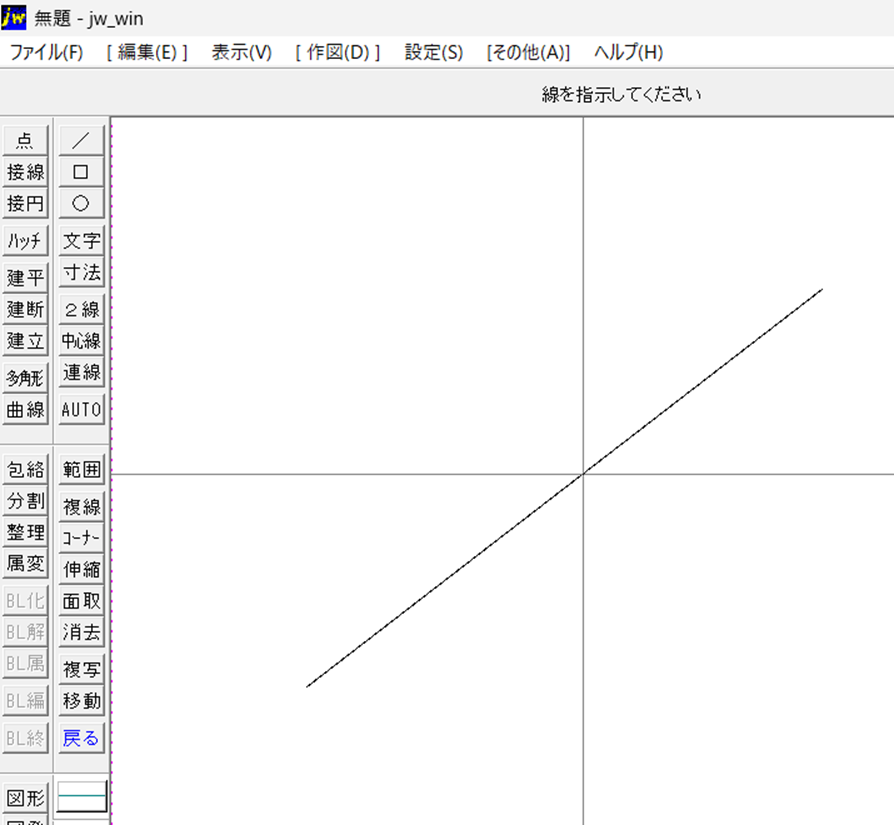外部変形は データのやり取りをテキストファイルで行うので プログラム言語は 自由に選ぶことができます。図形は機能的かつシンプルなため、数多くのユーザーに受け入れられています。
luaで線に直交線を引く
:luaで線に直交線を引く
@echo off
for /f "delims=:" %%n in ('findstr /n "^#!" %0') do (
copy jwc_temp.txt myfiles > nul
more +%%n %0 | lua > jwc_temp.txt
)
goto:eof
REM #jww
REM #1ln 線を指示してください
REM #bz
REM #e
#!この次の行からプログラムを書いてください
--ユーザー定義関数
function concat(a, ...) --配列を連結する
-- 例
-- concat({1,2},{3,4}) => {1,2,3,4}
if #{...} == 0 then return a end
if #flatten(a) > #a then
local i
local n = #a
local y = ...
for i = 1, #y do
a[n + i] = y[i]
end
return a
else
return flatten({a, ...})
end
end
function join(a, FS) --配列を平滑化してスペーサーで連結した文字列を返す
if type(a) ~= "table" then return a end
if FS == nil then FS = " " end
return table.concat(flatten(a), FS)
end
function flatten(a) --配列を平滑化する
local i, j, k
local c = {}
for i in pairs(a) do
if type(a[i]) == "table" then
--while #a[i] == 1 do a[i] = a[i][1] end
for j in pairs(a[i]) do
if type(a[i][j]) == "table" then
--while #a[i][j] == 1 do a[i][j] = a[i][j][1] end
for k in pairs(a[i][j]) do
table.insert(c, a[i][j][k])
end
else
table.insert(c, a[i][j])
end
end
else
table.insert(c, a[i])
end
end
return c
end
function echo(...) --配列を平滑化してスペーサーで連結した文字列を出力する
if #{...} == 0 then return end
return print(join({select(1, ...)}))
end
function polar(r, d, w) --方向余弦のセット
if r == "" or r == nil then r = 1 end
if d == "" or d == nil then d = 0 end
if w == "" or w == nil then w = 1 end
return {r * math.cos(d), r * math.sin(d) * w}
end
function moveto(x, y) --点x を 相対距離 y [ a, b ] へ移動
return y and ptcalc("+", x, y) or x
end
function polarto(x, r, d, w) --点x を 極座標 [ r, d ] で相対的に移動する
return moveto(x, polar(r, d, w))
end
function ptcalc(p, x, y) --点データの数値演算(加減乗除)
local zz
zz = {x[1], x[2], y[1], y[2]}
if p == "+" then
return zz and {zz[1] + zz[3], zz[2] + zz[4]} or {0, 0}
elseif p == "-" then
return zz and {zz[1] - zz[3], zz[2] - zz[4]} or {0, 0}
elseif p == "*" then
return zz and {zz[1] * zz[3], zz[2] * zz[4]} or {0, 0}
elseif p == "/" then
return zz and {zz[1] / zz[3], zz[2] / zz[4]} or {0, 0}
elseif p == "ave" then
return zz and {(zz[1] + zz[3]) / 2, (zz[2] + zz[4]) / 2} or {0, 0}
else
return {0, 0}
end
end
function ptdist(x, y) --2点間の距離を返す
local x1, y1 = x[1], x[2]
local x2, y2 = y[1], y[2]
return math.sqrt( (x2 - x1) ^ 2 + (y2 - y1) ^ 2)
end
function lnlength(s) --線長を返す
local x1, y1, x2, y2 = s[1], s[2], s[3], s[4]
return math.sqrt( (x2 - x1) * (x2 - x1) + (y2 - y1) * (y2 - y1))
end
function lnslope(s) --線の角度を返す
local x1, y1, x2, y2 = s[1], s[2], s[3], s[4]
return math.atan2(y2 - y1, x2 - x1)
end
function lnpoint(s, pm) --始点 pm=-1, 終点 pm=1 の座標を返す
local x1, y1, x2, y2 = s[1], s[2], s[3], s[4]
if pm == nil then pm = 0 end
return pm == 0 and {(x1 + x2) / 2, (y1 + y2) / 2} or (pm < 0 and {x1, y1} or {x2, y2})
end
function ln_hpnear(s, p) --指示点の近傍端点を返す
return lnpoint(s, ln_hpends(s, p))
end
function ln_hpends(s, p) --指示点の近傍端点の指標を返す(始点 pm=-1, 終点 pm=1)
local l1, l2
l1 = ptdist(p, lnpoint(s,-1))
l2 = ptdist(p, lnpoint(s, 1))
return l1 < l2 and -1 or 1
end
--本文
for line in io.lines("myfiles") do
F = {}
string.gsub(line, "%S+", function (x) table.insert(F, x) end)
if line:match("^hq") then print("bz") end
if line:match("^hp1ln") then p1 = {F[2], F[3]} end
if line:match("^ ") and #F == 4 then
ptc = lnpoint(F)
--直交線の位置を始点、中心点、終点で決めるときの補正
ptc = ln_hpnear(concat(ln_hpnear(F, p1), ptc), p1)
l = lnlength(F) / 2
d = lnslope(F) + math.rad(90)
echo(polarto(ptc, -l, d), polarto(ptc, l, d))
end
end


作図用ライブラリ jw.lua を用意しておけば下記のようになります。
:luaで線に直交線を引く(jw.lua)
@echo off
set LUA_PATH=%~dp0jw.lua
for /f "delims=:" %%n in ('findstr /n "^#!" %0') do (
copy jwc_temp.txt myfiles > nul
more +%%n %0 | lua -ljw - myfiles > jwc_temp.txt
)
goto:eof
REM #jww
REM #1ln 線を指示してください
REM #bz
REM #e
#!この次の行からプログラムを書いてください
jw() --jwc_temp.txt の書き出しデータを取得する
bz()
l1 = ln(1) --指示線(1)
p1 = hp(1) --指示点(1)
ptc = lnpoint(l1, 0) --指示線(1)の中心点
--直交線の位置を始点、中心点、終点で決めるときの補正
ptc = ln_hpnear(concat(ln_hpnear(l1, p1), ptc), p1)
l = lnlength(l1) / 2
d = lnslope(l1) + rad(90)
echo(polarto(ptc, -l, d), polarto(ptc, l, d))